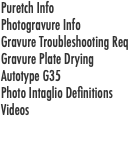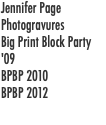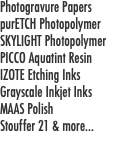 | ||||||||||||||||||
 |  |  | ||||||||||||||||
 |  |  |  | |||||||||||||||
Problem 1: Film coming off when removing top mylar for development Cause & Trearment: Moisture is not being removed from film after water lamination. Make sure film is squeegeed evenly and firmly. A climate controlled room is strongly recommended. Use a blown heater or hairdryer to remove moisture from film and improve adhesion. If you are not able to get plate surface up to 180ºF then dry the plate for much longer time than recommended. Humidity in shop may also be too high, relative humidity should be 65% or lower. Plates can be dried overnight without heat in proper humidity. It is a good idea to laminate several plates at one time and dry overnight for exposure the next day as this saves time and energy. A wet-dry bulb hygrometer is highly recommeded to monitor relative humidity in the shop. Try dry lamination if the problem is persistent. Problem 2: White, cloudy spots forming under film after lamination Cause & Trearment: Usual cause is the film has not fully dried due to high humidity, see Problem 1. Another cause is too much water is left behind after squeegeeing. The squeegee may be in bad shape and not applying even pressure. We recommend buying a 4" urethane squeegee at our store and lightly sand the edges with 1500 grit sandpaper. A firm and smooth squeegee will evenly remove the laminating water. Try dry lamination if the problem is persistent. Impurities on the plate or lamination water may also be to blame. 1. Use distilled water for lamination. If using paper towels on clean copper, Bounty is preferred to other brands because it is chemically free. Powdered cleansers and contaminants not rinsed fully are also possibly to blame, check humidity first. If problem persists and humidity has been ruled out, eliminate powdered clenser and switch to a good metal polish, followed by a high strength degreaser such as TSP, Tri Sodium Phosphate/90. Do not use cleaners with orange oil or D-limonene. DO NOT SAND YOUR PLATES. Sanding plates makes microscopic valleys and ridges that can trap cleaners and prevent Puretch from adhering because it may not let Puretch reach the valleys. This method only works for thicker films and is not recommended for Puretch. Sanding plates creates too much plate tone and can also negatively affect resolution fidelity because the surface is roughened and may refract light during exposure. Problem 3: Not able to etch small dots in hilghights Cause & Trearment: Problem 4: Film breaking down during development Cause & Trearment: Exposure may be too short, use a Stouffer to determine correct exposure, do not adjust development time, always keep this standard and adjust exposure. If exposure has been ruled out then usually the film has not dried fully after laminating it to the plate with water. The mylar may remove properly but areas that should remain on the plate will swell during development and eventually come off. The film needs to be dried longer. See problem 1. Problem 5: Plate not biting evenly, streaky or splotchy Cause & Trearment: Problem 6: Film not adhering at edges of plate Cause & Trearment: Do not bevel plates before lamination. A slight burr from shear may cause an air pocket at edge, carefully knock this off with a scraper or file without over beveling. Clean back of plates around edges to keep grease, etc from creeping in at edges. Always trim film from front side of plate with very sharp blade. Do not prop plates on edge for drying, this can cause delamming at that edge, dry flat instead. Problem 7: Small holes in film and etch Cause & Trearment: Dust and dirt particles in lamination or exposing unit. Clean glass in contact frame on both sides with razor blade and glass cleaner. Always work in a clean, dust free lamination room. Use a dust roller on plate prior to spray and lamination. Inspect plate and retouch pinholes with paint marker or asphaltum prior to etching. Problem 8: Film is not exposing and developing like it was previously Cause & Treatment: Film may be old or stored improperly. Puretch has a one year shelf life, check date of purchase. Store film in black bag in the box between 40 and 70ºF and between 30% and 65% humidity. The shelf life may be extended beyond a year if it is stored in the cooler temps within this range. If you do timed exposures and don't use a light integrator, your light source may have weakened. Do a Stouffer test to determine how film is responding and make necessary adjustments. | ||||||
 | ||||||
 | ||||||